Dog Coat Colour Genetics (original) (raw)

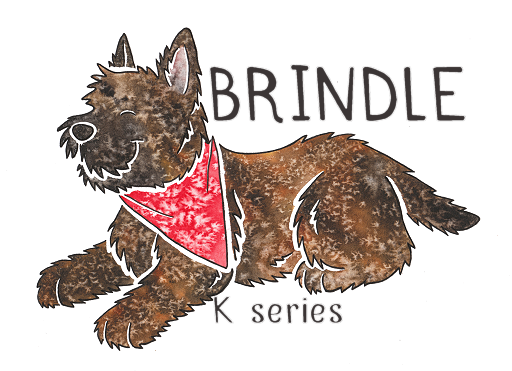


The Brindle Gene
Brindle is one of the alleles on the K locus. There are three K locus alleles - KB (dominant black), kbr (brindle) and ky (non-solid black - allows A locus to be expressed). KB is the top dominant and ky is the bottom recessive. kbr sits between the two. It is entirely dominated by KB (so just one KB allele will stop brindle from being expressed), but is dominant over ky, so a brindle dog can have the genotypekbrkbr or kbrky.
A dog with one or two kbr alleles will express whichever alleles it has on the A locus, but any and all phaeomelanin (red) in the coat will be brindled. This means that the extent of the brindling on the coat depends on the A locus. The following list shows how the different A locus genes affect the appearance of brindle.
Brindle + AyAy (sable) - dog will be solid brindle (possibly with darker areas on the back and head where the tipping on the sable would be)
Brindle + atat (tan points) - dog will be black (or liver/blue/isabella) with brindle points
Brindle + awaw (agouti/wolf grey) - effect on dog is unclear as these genes rarely occur together, but the brindle would likely appear broken and patchy
Brindle + aa (recessive black) - dog will be solid black, liver, blue or isabella (recessive black does not allow the production of phaeomelanin in the coat)
Brindle typically appears as black stripes on a red base. The stripes are eumelanin and the base is phaeomelanin, so the appearance of those pigments can be changed by any of the genes which usually affect them.
- Eumelanin (the pigment making up the stripes) can be affected by: merle (and harlequin), liver, dilution, greying, and recessive red.
- Phaeomelanin (the pigment making up the base) can be affected by: Intensity locus.
And of course, white markings and ticking can occur on any brindle dog.

Brindle is caused by a complex gene process and is technically a form of mosaicism, where some cells express one allele (KB) and some express the other (ky), a little like tortoiseshell cats. This makes it very difficult to test for, and there are currently no commercially available tests that are able to detect brindle. Brindle dogs will usually test as KBky, and carriers (one dominant black allele, one brindle) cannot be identified without breeding.

Variations in Striping
Stripe width can vary greatly, and it is not known which genes, if any, are responsible for this variation.
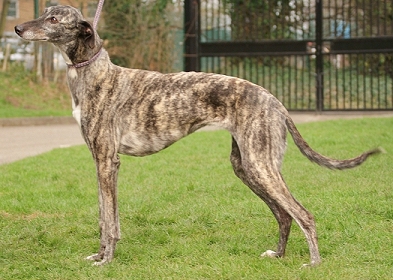
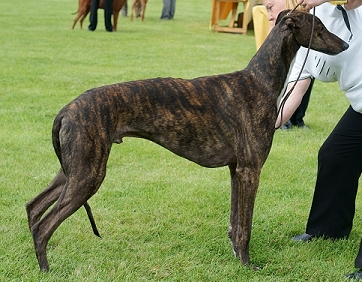
These two Greyhounds represent a typical "light" or "red" brindle and a typical "heavy" or "dark" brindle. A brindle is light when the overall appearance is of a red dog and heavy when the overall appearance is of a black dog, although terminology can vary across breeds.
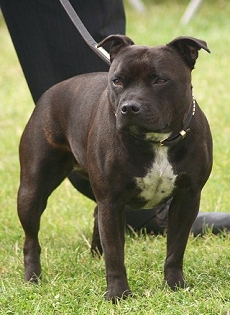
This Staffie shows even heavier black striping than the Greyhound above. There is only a very small bit of tan visible on the hip, and the rest of the dog appears solid black. This type of striping is sometimes called "black brindle" or**"reverse brindle"**.

Variations in Base Colour
The base colour on a brindle can vary as much as red can usually vary, from a deep Irish Setter colour to a light cream. A light base coat on a brindle is generally due to the Intensity locus, which dilutes phaeomelanin (red pigment) to cream, but has no effect on eumelanin (black pigment).









These are all details taken from photographs of brindles with black stripes.

Brindle with a Mask
A dog that has at least one Em allele on its E locus will have a black mask. This is an area of eumelanin covering the muzzle and sometimes the ears. If a dog is a brindled sable (brindle gene + sable gene), it'll be brindle all over, and on dogs like this masks may be visible.
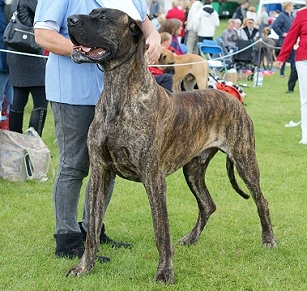

You may notice that on the Great Dane above the phaeomelanin (red) is deeper on the back and on the chest and legs is almost white. This is most likely due to the urajiro pattern (see the C and I locus page). As urajiro only affects phaeomelanin, the black stripes are unaffected. However, the light base colour can make the stripes seem greyish (see below).

Silver Brindle
Sometimes a brindle dog with black pigment may have what appear to be silver stripes, usually on a cream background (never deep red). The overall effect may be similar to how a blue brindle (dd dilution gene) would look. Silver brindle is often caused by the greying gene (G locus), which turns black to grey as the dog ages.
Sometimes dogs with black stripes and a very light cream base (see above) are also referred to as silver brindles. This is because the pale base can cause the black stripes to appear lighter than they actually are. This is often seen in Japanese Akitas, for example.
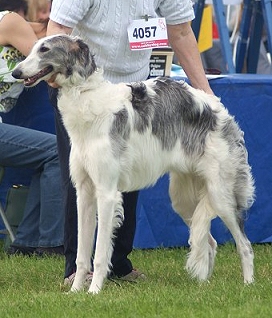
This silver brindle Borzoi is most likely an example of a grizzle/domino (Eg) brindle (see below). Some grizzles can have a greyish cast due to other gene interactions.

Brindle and Long Fur
Long, wirey and curly fur can obscure brindle markings by making the stripes less distinct.

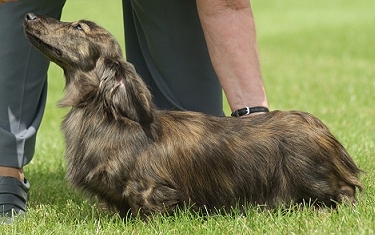
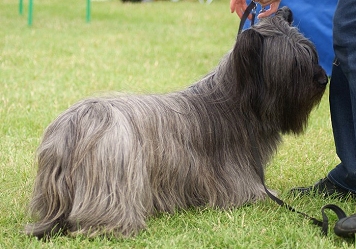
Even between longhaired breeds, the visibility of brindle can vary. The Dachshund here has very distinct stripes and is obviously a brindle, but the Skye Terrier just appears to be a muddy grey/brown. The main way we can tell this Skye is brindled is simply its muddy-coloured coat - this shade occurs almost exclusively on brindles and not on normal solid reds or sables. It also appears to have some lighter and darker areas, which also suggest it is a brindle.

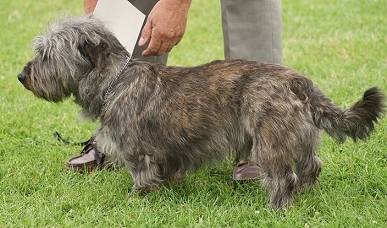
This Glen of Imaal's brindling is very obvious on the short fur on its body, but less obvious on the longer fur on its head. If the Skye above were to be clipped down, it would look something like this. The brindling is still present as normal at skin level, but becomes obscured by long coats.

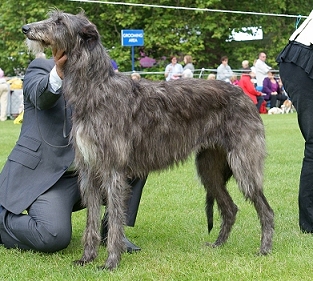
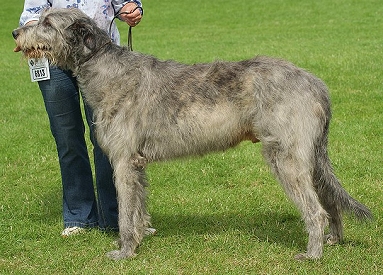
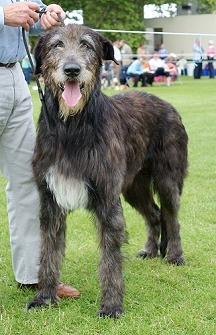
These Wolfhounds and Deerhound show brindling on wirey coats. On the first two dogs, greying has caused the black striping to fade out.

Brindle Tan Points and Saddle Markings
Because the brindle gene allows expression of the A locus, any A locus coat patterns can show brindling on their red sections. The main patterns are sable (AyAy) and tan points (atat). A sable brindle will appear solid brindle (in fact, all solid brindles are sables), although any areas of shading will remain dark. A tan pointed dog with the brindle gene will appear black/liver/blue/isabella with brindle points instead of tan.

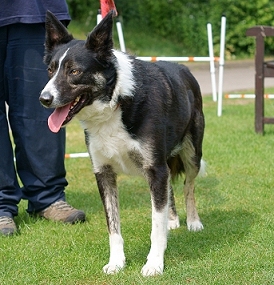
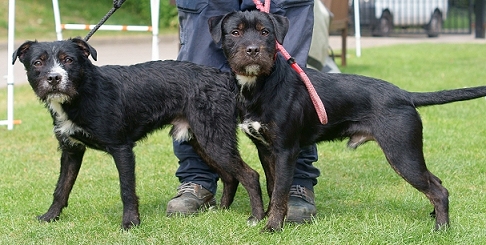

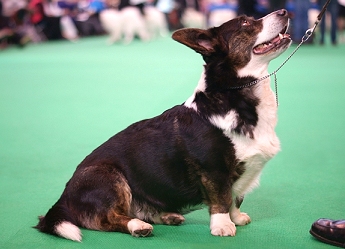
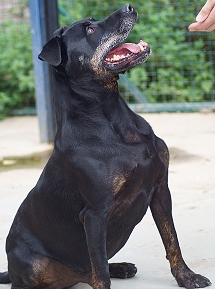
All of these dogs display black-pigmented dogs with brindled points, with or without white markings.

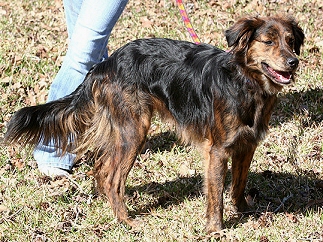
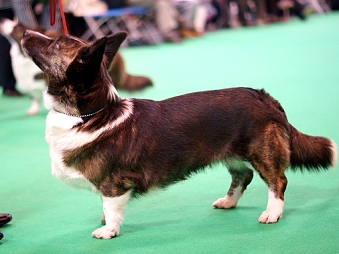
Crossbreed photo by (unknown)
These two dogs are brindle with saddle markings(atat plus the RALY saddle tan modifier, see the Agouti page). Note the large areas of solid black on the back and brindled tan on the legs and head. The Cardigan Welsh Corgi also shows white in the irish spotting pattern.

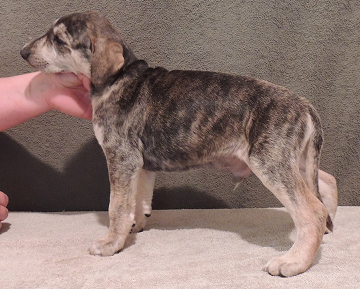
Brindle Saluki puppy photo submitted by Tara Meikle
There is one apparent exception to the rule that only the tan areas on a dog show brindle striping. Dogs with the Eg (grizzle/domino) allele seem to show brindle mostly on their darker areas or saddles, as the Saluki puppy above shows. These dogs look very similar to a saddle tan or shaded sable, but the pattern is caused by a different mechanism. See the E series page for more information on grizzles and how Eg interacts with brindle. It is possible that the Eh allele (which causes a similar pattern in Cocker Spaniels) and the Ed allele (Northern domino, in Husky types) interact with brindle in a similar way too.

Brindle Merles

A brindle with stripes that appear to be broken up into shorter stripes and spots may be a merle. As with the Staffordshire Bull Terrier cross shown above (submitted by Ally Stern), the effect can be very subtle. Brindle merles are dealt with on the merle page.

Liver and Dilute Brindles
A brindle dog will have liver (brown) stripes if it is bb on the B locus, blue stripes if it is dd on the D locus, and isabella stripes if it is both dd and bb. Dilution affects phaeomelanin (red) too to some extent, so the base colour will be relatively light (certainly not a deep red colour, but more likely cream).

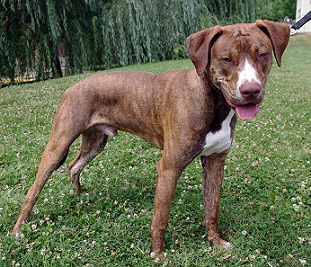
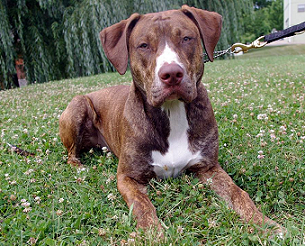
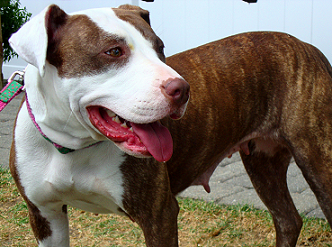
The first two photos show Ambrose, owned by Julie, and the third photo was kindly submitted by Abby L
Liver brindles. Liver and brindle do not occur together on many breeds, however the combination is fairly common in Pit Bull types.

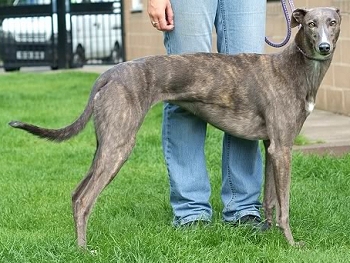
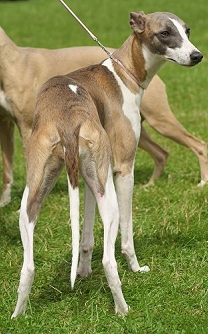
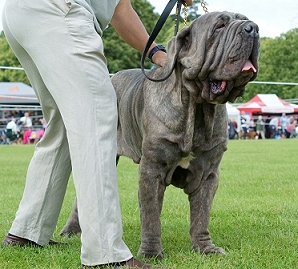
Here are three blue brindles. The Whippet is a very light brindle, and the blue colouration is mostly visible on the mask and nose. The Neapolitan Mastiff, on the other hand, is a heavy brindle, so the overall appearance is blue.
When the liver and dilution genes are combined, the result is isabella (lilac). Isabella brindles are extremely difficult to distinguish from a solid isabella as the stripes and the base coat are such a similar colour. Neapolitan Mastiffs are one of the few breeds where dilution, liver and brindle all occur together.

"Missing" Stripes
On some light brindles there may be solid red areas where it appears stripes are "missing". This is particularly common in Whippets, but the genetic basis is unknown. Have a look at the Whippet below. In the first picture the brindle appears normal, however in the second picture you can see a large clear area on the dog's side.
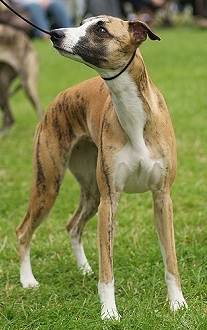
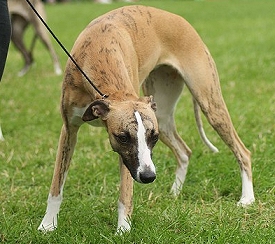

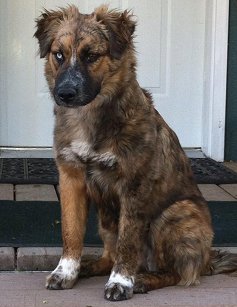
Sophie, submitted by Helen Lottridge
The stunning mixed breed above appears to have some missing stripes on the inside of her front leg.

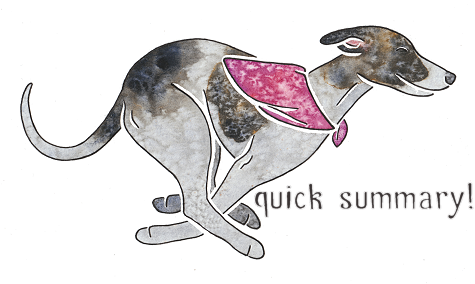
Quick Summary!
No time to read the whole thing? Here's the quick version!
Brindle (kbr) is in the middle of the K locus, recessive to KB but dominant over ky. If a dog is kbrkbr or kbrky then it will display its A locus genes, just like a kyky dog, but any phaeomelanin (red/tan) in the coat will be brindled.
The dark (eumelanin) stripes on a brindle can be affected by liver, dilution, greying or merle, and the light/red (phaeomelanin) stripes can be affected by the Intensity locus. The thickness of the stripes can vary, so the dog may look predominantly dark or predominantly red.
Dogs with the Eg gene (Salukis, Borzoi, Afghan Hounds) are affected differently by brindle, with the brindling appearing mostly on the dark (eumelanin) areas of the dog. This accounts for examples of dogs that appear to have brindled saddles but no brindling on the legs.

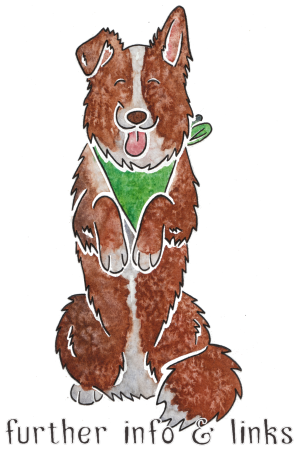
Further Info and Links
Brindle in dogs is located on the K locus, which is CBD103 (Canine Beta Defensin 103). It is an unstable allele that causes some cells in the body to act as KB (dominant black) and some to act as ky (non-black), in a similar way to a chimaera (fusion of two embryos) or to a tortoiseshell cat (X-chromosome inactivation). In fact, in horses there is no gene for brindle, and when brindle occurs it is always indicative of a chimaera. Brindle dogs are not chimaeras, however, but they are mosaics, which is when different cells in the body become genetically distinct during development. There are many different types of mosaics, but tortoiseshell cats are one type (X-chromosome inactivation means that some cells switch off the black allele and some switch off the red allele - see the "Notes on Mutation etc" page for a full explanation). Interestingly, a form of mosaicism in humans results in a brindle-like pattern known as Blaschko lines.
Because a brindle dog will have some cells expressing ky and some expressing KB, this makes testing for brindle extremely difficult. There are currently no commercial tests available for the kbr allele, but the allele has been identified by at least one laboratory. In commercial testing, brindles generally test as KBky.
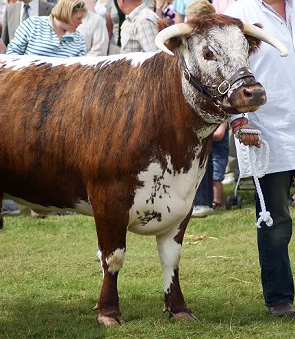
Apart from horses and dogs, one of the only other species that appears to have a similar brindle pattern is domestic cattle, like the bull above. The gene causing brindle in cattle has not yet been located, but as it is common and inherited it can't be caused by chimaerism, as in horses, and cattle are not known to have any BD103 colour genes, so the mechanism must be different to brindle in dogs.
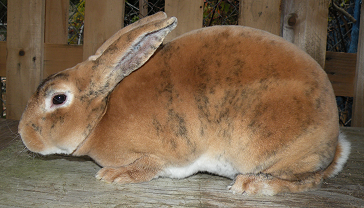
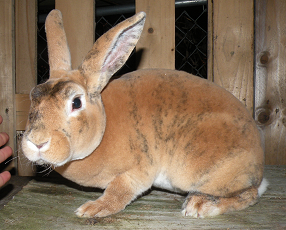
The "harlequin" pattern in rabbits, as shown by Wasabi here (submitted by Beth), can look similar to brindle in dogs. The mechanism does seem to be fairly similar, with some areas of the coat unable to produce eumelanin and some unable to produce phaeomelanin. The visual effect is somewhere inbetween tortoiseshell in cats and dog brindle, as the effect on more heavily marked rabbits is of large stripe-like patches.
Links to studies:
Linkage and Segregation Analysis of Black and Brindle Coat Color in Domestic Dogs: http://www.ncbi.nlm.nih.gov/pmc/articles/PMC1931550/


** Please note that I am not a research scientist, and the information on this page comes from my own knowledge and observation of dogs, observational and testing data provided via e-mail by site visitors, any research papers linked on the page, and the information provided by Dr Sheila M. Schmutz on her excellent website http://homepage.usask.ca/\~schmutz/dogcolors.html
For further genetics resources, see the Links page
